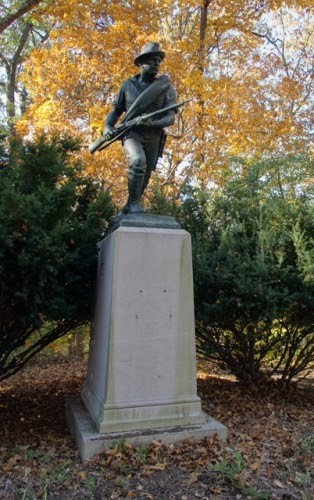Westville's Whalley Avenue
By Jenahn Dawson
Whalley
Avenue in New Haven, which connects Downtown to the Town of Woodbridge through
six city neighborhoods, is one of the most important roads in the city. Named after the celebrated regicide Edward
Whalley, the Westville section of this vital route was home to many commercial
businesses, halls, taverns, shops and the location of the infamous raid by the
British Army.
Whalley Avenue was first laid out in 1797 to connect Broadway and Downtown with the Litchfield Turnpike. Much of the Avenue went undeveloped until the late-19th century when the horse-drawn streetcar made residential development possible beyond the city core. One notable early resident was Sherriff Joshua Hotchkiss, who along with his prominent family moved to the area of present day Whalley and Blake streets in 1677. (Caplan 9) With a large family, the small hamlet was titled Hotchkisstown.
Prior
to the construction of the Westville Bridge on Whalley Avenue, which occurred
soon after the Litchfield Turnpike was chartered, Westville was accessed from
New Haven by way of Goffe and Blake Streets. In March of 1843, a catastrophic
storm of snow and rain covered then weakened Westville bridge, sending a man
along with his two horses to their deaths (New Haven Palladium). It would take more than two decades and various
attempts until any tangible progress was made on the creation of a new bridge over the West River.
Bogged down by slow and muddy lanes, inventor Eli Whitney Blake introduced the first paving method for Whalley Avenue using stones from nearby West Rock in 1852 (Caplan 47). When Whalley Avenue finally became the primary route to Westville in the early 19th century, the portion that winds through the center village was referred to as Main Street until 1897. Soon, the Town of Westville was consolidated with the City of New Haven (New Haven Register 1929). Having just a single lane traveling in each direction, this segment of Whalley Avenue is the narrowest stretch of the road.
Soon
after, the horse-drawn trolley system connected Westville Village with the
central city in 1861, allowing it to grow to a greater degree. During the late
1860s, Whalley Avenue began to make a transition from a predominantly
residential area to a more commercial core. Operated by the Fair Haven and
Westville Horse Railroad, tracks from Grand Avenue to Whalley Avenue were laid,
connecting smaller branches that led through downtown to the main railroad station
and elsewhere. (Caplan The Daily Nutmeg)
A
cornerstone of the Whalley Avenue streetscape is the narrow frame Queen Anne
house. By mid-19th century, as was happening in other places of New Haven,
these houses began appearing on Whalley Avenue as commercial blocks. These were
houses built specifically to combine ground-floor money-making space with
living lodgings in the upper levels. For example, 904-06 Whalley Avenue was
built for Frederick Roth in 1880 specifically as a shoe store and as his
residence. (New Haven Preservation
Trust).
Currently
the Westville Village Historic District encompasses a small, but densely
developed commercial area that reflects the area’s history as the commercial
center of Westville, which directly served the mills on the West River. This quaint, charming community is a
well-preserved neighborhood that endures to present the story of the area’s
development as a commercial and manufacturing center. The scale and concentration
of the commercial and residential architecture is symbolic of the original
layout of the community. The sound of church bells, factory whistles, and horse
shoes was common and familiar, now replaced by pedestrians, galleries and fine restaurants.
The
Westville Village is historically significant for its contribution to New
Haven’s growth as a major industrial center from the second half of the 19th
through the mid-20th century. In contrast to the light manufacturing and commercial
concerns located in downtown New Haven during this time, Westville was home to
larger industrial factories which took advantage of the open space and
waterpower from the West River.
There
are churches of many faiths within Westville. The first church on Whalley
Avenue in Westville was the St. James Church belonging to parishioners of the
Episcopal Parish. Stanton Pendleton, an ardent Episcopalian, helped purchase
the prospected lot near Edgewood Park for the church. Construction for the church
began in June of 1837, and was fully completed two years later. The first
serving Reverend was Henry McGlory, who served from 1853 through 1855. After nearly eight decades of use, signs of
deterioration were evident and the church was rebuilt. (Caplan 64)
Past
the Village, Whalley widens again to 48-feet to accommodate two travel lanes in
either direction. Originally passing fields and farms on the way to Woodbridge
along the Litchfield Turnpike, this segment of Whalley now travels through the
Amity section of Westville, which developed small commercial strip malls during
the 20th century. Sidewalks here are narrow, not shaded, and are exposed to the
hustle and bustle of everyday life.
Connecticut
Historical Society
Barber,
John Warner, 1798-1885
http://hdl.handle.net/11134/40002:9641
"Local Views of New Haven and Vicinity"
Photo Taken by H.S Peck New Haven 1865
Courtesy of The New Haven Museum
Bibliography
Caplan,
Colin. Westville: Tales from a Connecticut Hamlet. Charleston, SC: The History Press,
2009Caplan, Colin. Time Travel, “The Daily Nutmeg”, August 5, 2015
http://dailynutmeg.com/2015/08/05/trolley-history-time-travel/
“Churches of New Haven St. James”: New Haven Register, December 15, 1929
“Storm and Freshet”: New Haven Palladium, 1843
“Westville Forty-Five years ago, Recalled by a
Former Resident”:
New Haven Register, February,6 1915
New Haven Register, February,6 1915
“Westville Village Historic
District”: New Haven Preservation Trust
http://nhpt.org/index.php/site/district/westville_village_historic_district/
http://nhpt.org/index.php/site/district/westville_village_historic_district/




Comments
Post a Comment